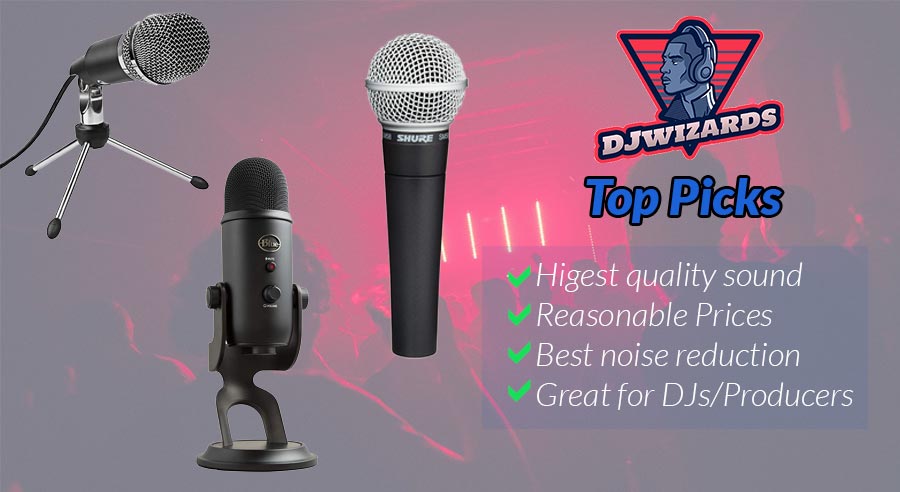
Whether you are an audio junky or a professional record producer, having high-quality sound is a must. You’re not going to get anyone’s attention with bad audio quality. In this post, we’ve determined what the best microphones of 2020 are under $100. We’ll also be giving you the features of what each has to offer.
These are the Top 3 Budget-Friendly Microphones for 2020
SHURE SM58 – LC Cardioid Dynamic Vocal Microphone ($99)
This is a unidirectional condenser microphone which is good for podcasting, studio recording, and for events. If you want high sound quality, this is it. This microphone has a variety of properties that makes it top of the list. It’s a staple in the industry and you can get it for under $200 on Amazon. It can also withstand the harshest conditions.
Blue Yeti Blackout Edition Microphone ($105)
This microphone is a dynamic microphone with several properties. It has several settings that can be useful in several audio conditions. This device can be used as your go-to audio device for your podcast, video, audio recordings or as your studio microphone. It has volume control to control the input volume and has a mute button that you can use when you don’t want the microphone to receive sound. It also has four recording modes that are stereo, omnidirectional, cardioid and bidirectional. This device costs about $105 on Amazon which makes it both pocket and budget-friendly.
Fifine K699B Microphone – Plug and Play ($30)
This is a dynamic microphone and it uses several outputs which include a USB cable output. This device has very good noise rejection and several audio modes. This microphone was released in 2018 and it’s one of the latest microphones out there. Its USB cable however is just six feet long and is attached to the microphone permanently which makes it not flexible for other output options. It’s mostly suitable for a recording studio or podcast and also video but you’ll need extensions for the output. That being said, it’s one of the best and cheap microphones out there retailing around $30 on Amazon.
Why we picked our winner: The SHURE SM58 – LC Vocal Microphone
- Noise handling: The SM58 has good sound reception due to its pneumatic shock mount which keeps vibrations from within the microphone and prevents shocks from being transmitted. This makes handling easy when you are using it since it doesn’t restrict you from making movements. It also has an incredible ability to keep out wind noise. This microphone has one of the best if not the best noise handling shock mounts.
- Durability: This microphone can withstand being run over by a sedan twice and it will still work. It’s called the world’s toughest microphone for a reason. It can withstand drops from critical heights and resistant to water, beer and even a microwave.
Features to look for in a quality microphone
When it comes to audio devices like the microphone there will always be plenty to choose from. This has brought about debates on which brands are best. While we know that brand loyalty can sometimes be blinding, we want to show you exactly what to look for in a microphone and why you should look for these specific features. It’s also very important for you to know what you are using, its capabilities, strengths, and weaknesses. Crucial features to look for in a microphone include:
- Quality of audio output: The only reason we buy audio devices is that we want good audio quality. Sometimes you find that some devices have a lot of frictional sounds that result from airbrushing on the mesh.
- Durability: Important if you want to save money but it also reduces the amount of stress of the mic. Durability however does not mean that it will keep up with upcoming technological advancements. To check durability, look at the body of the device. Is the cover of the mic plastic or metallic? If your budget allows, go for the metallic one.
- Flexibility: When buying a mic or any audio recording device for that matter, do you want to keep buying them every year or every time a new update is available. Having something that doesn’t require frequent updates is freeing. When choosing a microphone, just make sure it can accommodate your needs today and what you may want to use it for in the future.
Future trends in microphones (smaller sizes)
Difference between dynamic and condenser mics
When it comes to microphones, there are two major types: dynamic and condenser microphones. These microphones are quite different in both functionality and application. If you’re unfamiliar with the differences, read below.
Dynamic Microphones
First, let’s look at dynamic microphones. From its design the microphone does not use traditional coil in its core, it uses plates instead of coils. It also functions differently vs. a condenser. It’s an omnidirectional sound receiver which means that it can take the sound from all directions of the microphone. You can talk from all sides of the microphone and still have your input. They have high rejection of background noise and give out more natural sound.
Condenser Microphones
The condenser microphone is a traditional microphone and the oldest. It still uses coil technology in its system to create audio but one of the best microphones still lying around. The microphone is cardioid or unidirectional in its reception of audio. Unidirectionality means that the microphone can only receive audio from one direction which is what’s in front of the microphone. They pick up high-frequency sounds and is more suitable for a controlled environment.
About Microphones in General
If you want to master anything, you need to understand your tools and in the music industry, that includes our gear. A microphone uses electrical power to convert waves to sound that’s transmitted via cable to existing sound instruments. The microphone has been around since 1876 when Alexander Graham Bell decided to bring his idea into life. From that time, its gone through some major changes in size. Microphones are not just audio devices, it helped pioneer creativity and music. Amplify your mixes and sound with the right gear.

